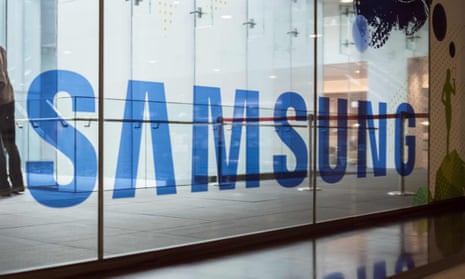Samsung’s Galaxy S8 will come in two sizes, have an almost bezel-less, edge-to-edge “infinity” display and an iris scanner, the Guardian has learned.
The Galaxy S8 will be announced in late March and go on sale on or around 21 April, later than the originally planned launch at Mobile World Congress in Barcelona in February due to knock-on effects of the Note 7 fiasco.
The two variants will have screens in the 5in to 6in region, with the devices having the same or smaller proportions of previous versions of Samsung’s flagship smartphone but with larger displays, according to several well placed sources talking to the Guardian. The S7 was available with either a 5.1in and 5.5in screen.
The two smartphones are codenamed Dream and Dream 2, representing the smaller and larger Galaxy S8 respectively, according to two sources. Both versions will have screens that curve down at the left and right sides of the device similar to the Galaxy S7 Edge, two sources have said.
The so-called “infinity display” will cover the majority of the front of the device, with very little body on the top and bottom of the screen not dedicated to the display. Two sources said there wasn’t even room to put a logo or brand name on the front of the device. Samsung has moved the fingerprint scanner to the back of the device, multiple sources said. The Galaxy S8 will have a traditional 3.5mm headphone socket, according to several sources.
Several sources also confirmed that the iris scanning biometric technology launched in the ill-fated Samsung Galaxy Note 7 will be available on the Galaxy S8, allowing users to unlock and their smartphones and authenticate purchases with their eyes.

The Galaxy S8 will have a similar “duo pixel” camera to last year’s Galaxy S7, situated on the back of the device according to two sources, with incremental improvements to image quality, low-light performance and speed. The camera will also feature built-in object recognition, similar to Google Goggles, according to several sources.
The Galaxy S8 will have a new processor, this time built on the company’s 10nm technology making it one of the first to do so, said two sources. Chipmaker Qualcomm recently announced the Snapdragon 835, which is being built using Samsung’s new 10nm processes.According to two sources, the new device will also come with 64GB of storage built in, as well as expandable storage via microSD card, with support for cards up to 256GB in capacity. The phone will also have USB-C and a new version of Samsung’s Gear VR headset and Gear 360 camera.
The Galaxy S8 will also come with an artificial intelligence assistant, which can perform tasks such as object recognition, using the smartphone’s camera similar to Google Goggles. Two sources also said that Samsung was partnering with others to include data sources for the AI assistant. Other information leaks have suggested that it could be called Bixby, based on the technology gained by the South Korean company in its acquisition of startup Viv Labs in October, but none of the sources talking to the Guardian could confirm the name. Whether the Galaxy S8 will also come with Google’s Assistant as well or instead in some markets was unclear.
Samsung also plans a range of new accessories for the Galaxy S8. Two sources said a new dock and service that turns the Galaxy S8 into an Android desktop computer, connecting to a monitor, keyboard and other peripherals called DeX (desktop extension) will be available. DeX has been likened to Microsoft’s Continuum, which connects Windows smartphones to a desktop extension to allow them to be used as Windows PCs, but only with Windows Store applications.
The below picture of a front glass plate is a good representation of what the Galaxy S8 will look like, according to two sources.
W tym lepiej widać zagięcie. Lekkie zaokrąglenie jest też na gorze i u dolu #GalaxyS8 pic.twitter.com/KXKfn6t9GO
— DforDesign (@dfordesign) January 18, 2017
Android has had the capability to act more like a traditional desktop computer, with some devices including Remix OS-based desktops taking advantage, but none of the big players including Motorola have had much success pushing the idea of using the smartphone as desktop replacement. Whether Samsung will be different with Dex remains to be seen, but the company has attempted to bring greater synergy between its Windows PCs and Android smartphones, using connectivity services that sync data and allow control of Samsung Android smartphones through Windows apps.
The sources spoke to the Guardian on condition of anonymity due to their relationships with Samsung. The Guardian believes their information to be correct at the time of publication and has double sourced all claims, but as is the nature of product development before the release of a smartphone or device, Samsung’s plans may change.
Following the high-profile failure of the Note 7 due to two separate battery faults that caused explosive failures of the phone’s integrity, Samsung needs a hit on its hands to continue the momentum it built with the design shift to metal bodies and curved screens started with 2015’s Galaxy S6 series.
Samsung is locked in a war over the so-called floating voter – the 20% of people likely to switch mobile operating systems - with Apple, but is also now fighting on a new front with Google and its own-brand Pixel smartphones.
Since the launch of the Pixel and Pixel XL there have been two high-profile, advertising-backed top-end Android smartphone manufacturers trying to convince existing users to upgrade. At the same time China’s Huawei has been gaining marketshare by offering both premium and well-made budget devices that are undercutting Samsung’s market, placing Huawei as third largest smartphone manufacturer as ranked by analysts firms IDC and Gartner.
A Samsung spokesman confirmed that the Galaxy S8 would not be unveiled at Mobile World Congress per its president of mobile communications DJ Koh’s comments on Monday. They added that Samsung does not comment on rumour and speculation.
